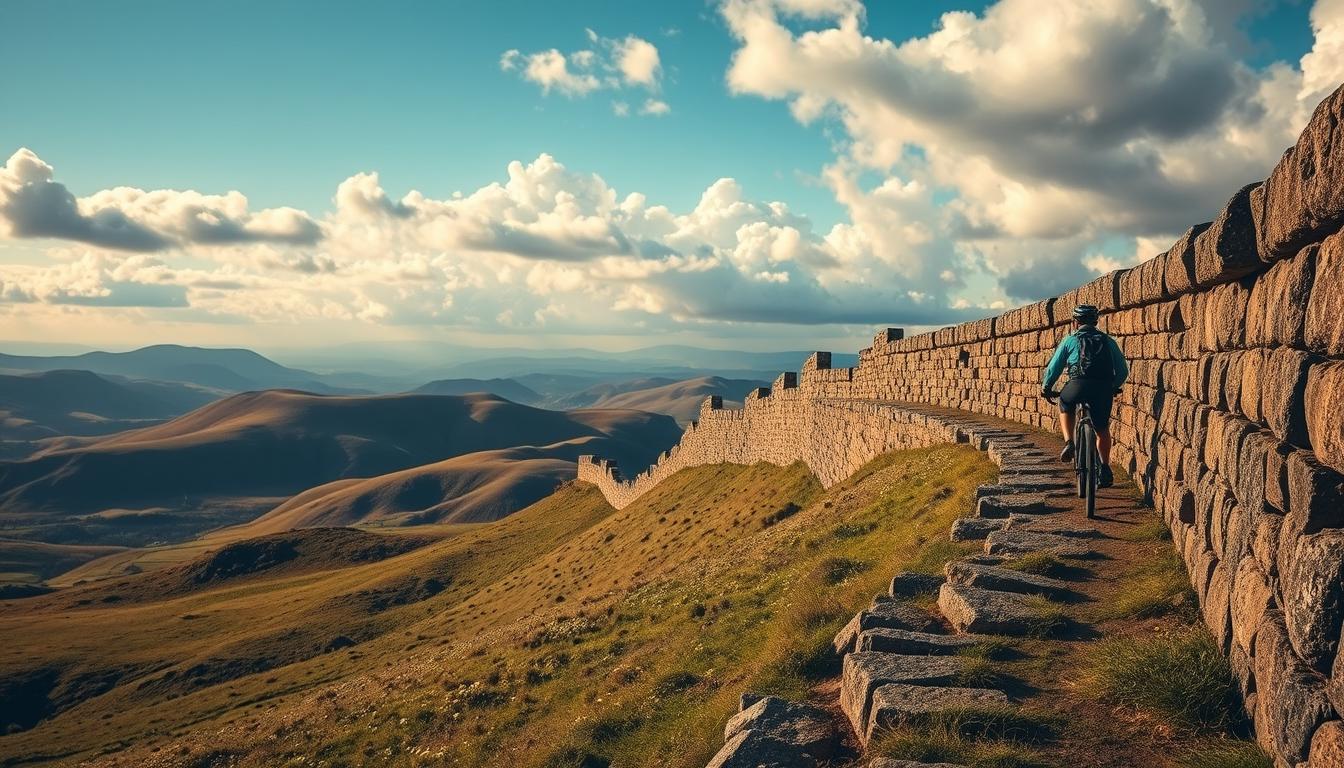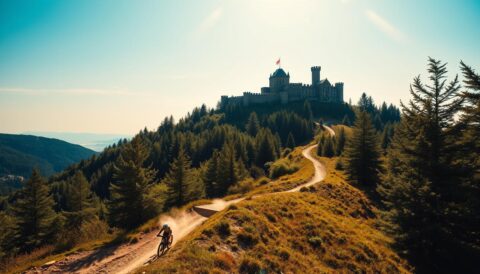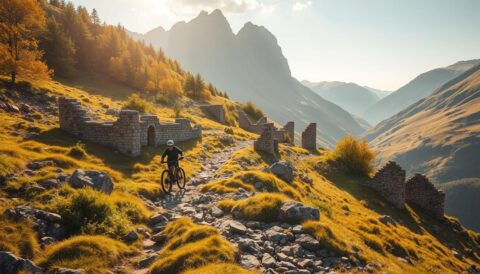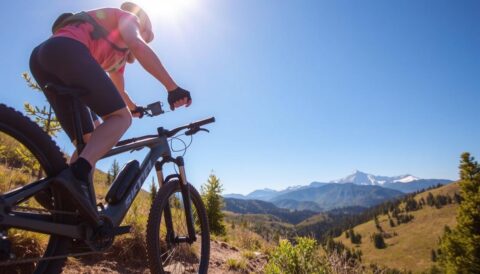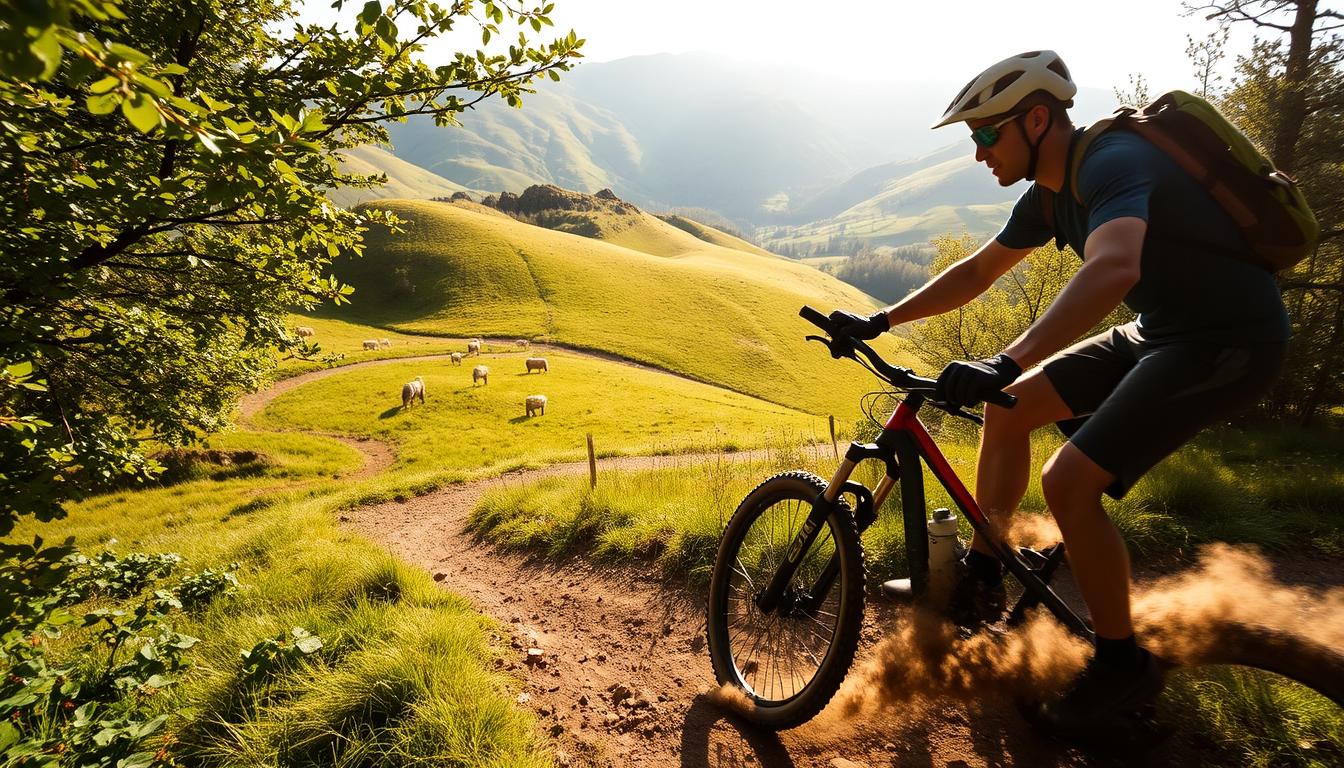Stretching across northern England, Hadrian’s Wall stands as one of northern Europe’s most impressive Roman monuments. This UNESCO World Heritage Site offers a unique blend of history and adventure, making it a must-visit destination.
For those seeking an active way to explore, the 84-mile trail provides an unforgettable journey. From the rolling hills of Cumbria to the rugged landscapes of Northumberland, the route is both challenging and rewarding.
Opened in 2003, the trail runs parallel to the 174-mile Hadrian’s Cycleway, offering options for cyclists of all levels. Whether you’re drawn to the physical challenge or the rich historical backdrop, this experience is truly one-of-a-kind.
In this guide, you’ll find practical tips and cultural insights to help you make the most of your adventure. Get ready to ride through history and discover the beauty of this iconic landmark.
Key Takeaways
- Hadrian’s Wall is a UNESCO World Heritage Site and a significant Roman monument.
- The 84-mile trail offers a mix of physical challenge and historical exploration.
- The route spans Cumbria and Northumberland, showcasing diverse landscapes.
- Opened in 2003, it runs alongside the 174-mile Hadrian’s Cycleway.
- This guide provides practical advice and cultural insights for your journey.
Introduction to Mountain Biking the Hadrian’s Wall Path
From Cumbria to Northumberland, this route is a journey through time. As a UNESCO World Heritage Site, it offers a unique blend of history and adventure. Whether you prefer walking or cycling, there’s something for everyone.
The walking path, designated as the 13th National Trail in 2003, spans 84 miles. For cyclists, the extended 174-mile cycle route (Route 72) opened in 2006. Both options showcase the beauty of northern England.
The terrain varies dramatically. You’ll encounter Cumbrian moors, Northumberland valleys, and everything in between. This diversity makes the journey both challenging and rewarding.
Historically, the trail follows the AD 122 defensive wall built by the Romans. It served as a barrier against invasions, adding a layer of intrigue to your adventure. Walking allows direct access to the wall, while cycling offers a coast-to-coast experience.
On average, cyclists complete the route in 3-4 days. Whether you’re drawn to the physical challenge or the historical backdrop, this trail promises an unforgettable experience.
| Aspect | Walking | Cycling |
|---|---|---|
| Distance | 84 miles | 174 miles |
| Terrain | Varied, including moors and valleys | Coast-to-coast, diverse landscapes |
| Historical Access | Direct access to the wall | Broader historical context |
| Average Completion Time | 5-7 days | 3-4 days |
Why Choose Mountain Biking the Hadrian’s Wall Path?
The Hadrian’s Wall Cycleway is a unique way to experience northern England’s heritage. This route combines exercise with open-air history lessons, making it ideal for intermediate riders. With a maximum elevation of 250m, it’s less demanding than other trails, such as the Coast to Coast route.
Cyclists will enjoy the flexibility of the path. You can extend or shorten daily stages to suit your pace. The route uses dismantled railways and quiet roads, ensuring a smooth and safe journey. Excellent waymarking and bike-friendly infrastructure make navigation straightforward.
Along the way, you’ll pass iconic Roman sites like Birdoswald, Housesteads, and Corbridge. These stops offer opportunities to combine cycling with short heritage walks. The scenery is diverse, from rolling hills to tranquil valleys, providing a visually stunning backdrop.
For those seeking a challenge, the cycleway offers a rewarding experience. It’s a fantastic way to explore the coast and countryside while immersing yourself in history. Whether you’re a seasoned rider or a casual cyclist, this route has something for everyone.
| Feature | Details |
|---|---|
| Elevation | Maximum 250m |
| Terrain | Dismantled railways, quiet roads |
| Historical Sites | Birdoswald, Housesteads, Corbridge |
| Flexibility | Adjustable daily stages |
| Navigation | Excellent waymarking, bike-friendly |
Planning Your Trip: Essential Tips
Planning your journey along this historic route requires careful preparation. Whether you’re a seasoned explorer or a first-time visitor, these tips will help you make the most of your adventure. From choosing the best time to visit to packing the right gear, we’ve got you covered.
Best Time to Visit
Timing is crucial for an enjoyable experience. Summer is popular for its vibrant atmosphere, but it can get crowded. For quieter trails and mild weather, consider visiting in spring or autumn. April to May and September to October are ideal for avoiding the rush while still enjoying pleasant conditions.
Accommodation near key sections like Steel Rigg and Sycamore Gap tends to fill up quickly. Booking early ensures you secure a spot in these sought-after locations. If you’re combining your tour with nearby attractions, Kielder Forest is just an hour’s drive from Haltwhistle and offers excellent trails for technical riding enthusiasts.
What to Pack
Packing the right gear is essential for a smooth journey. Here’s a quick checklist to help you prepare:
- Puncture kit: A must-have for cyclists to handle unexpected road issues.
- OS maps: These are invaluable for navigating different sections of the route.
- Lightweight lock: Perfect for securing your bike during heritage site stops.
For a comfortable stay, consider Herding Hill Farm. This cycle-friendly base offers secure storage and is an excellent choice for those looking to explore the area. With the right preparation, your trip will be both enjoyable and memorable.
Route Overview: What to Expect
The 174-mile route from Ravenglass to South Shields offers a diverse and scenic journey. Cyclists can expect a mix of landscapes, from the tranquil Cumbrian coast to rugged moorlands and urban fringes. This trail is perfect for those seeking both adventure and history.
Key Sections of the Path
The route is divided into three main stages. The western section features the serene beauty of the lakes, while the central area showcases the wild moorlands. The eastern section transitions into urban fringes, offering a unique contrast.
Must-see spots include the Banks Village wall approach and the dramatic Steel Rigg crags. These sections provide breathtaking views and a glimpse into the area’s rich heritage. For cyclists, secure bike parking is available at Walltown Crags and Steel Rigg.
Accommodation Options
Accommodation options along the route cater to all preferences. From cosy B&Bs to rustic bunkhouses, there’s something for everyone. Herding Hill glamping pods are a popular choice for those seeking a unique stay.
Recommended overnight stops include Haltwhistle, the mid-point of the journey, and Chollerford. These locations offer convenient access to key sites and amenities. While camping is an option, B&Bs near wall sites tend to be pricier but provide added comfort.
| Accommodation Type | Features |
|---|---|
| B&Bs | Cosy, convenient, and often include breakfast |
| Bunkhouses | Rustic and budget-friendly |
| Glamping Pods | Unique and comfortable, with modern amenities |
Historical Highlights Along the Way
Exploring the historical gems along this route offers a fascinating glimpse into Roman Britain. The hadrian wall is dotted with remarkable sites that tell stories of ancient engineering and military strategy.
One of the most impressive sections is at Walltown Crags, where a preserved portion of the wall showcases Roman craftsmanship. Here, you can see how the Romans built this monumental structure to withstand the test of time.
Milecastles and turrets played a crucial role in the wall’s defence. These small forts, spaced evenly along the route, served as lookout points and barracks for soldiers. Milecastle 39, located at Sycamore Gap, is particularly famous for its picturesque setting and historical significance.
“The wall was not just a barrier; it was a symbol of Roman power and ingenuity.”
For a deeper dive into history, take a one-hour detour to Vindolanda. This site is renowned for its collection of writing tablets, offering a rare insight into daily life during Roman times. The exhibition is a must-see for history enthusiasts.
Evening rides past illuminated forts create a magical atmosphere. The glow of these ancient structures against the night sky is truly unforgettable. Combining your wall cycle with the Hadrian’s Wall bus service allows easy access to these sites, making your journey both convenient and enriching.
| Key Sites | Highlights |
|---|---|
| Birdoswald | Best-preserved fort with stunning views |
| Housesteads | Complete Roman fort with museum |
| Vindolanda | Writing tablets and archaeological finds |
| Chesters | Roman cavalry fort and bathhouse |
This route is more than just a cycle path; it’s a journey through time. Each stop along the way offers a unique perspective on this world heritage site, making it an unforgettable experience for history lovers and cyclists alike.
Challenges and How to Overcome Them
Embarking on this route presents a mix of excitement and challenges, requiring both physical stamina and strategic planning. While the journey is rewarding, it’s essential to prepare for the obstacles you might face along the way.

Physical Demands
Covering 40+ mile days demands excellent saddle fitness, especially for cyclists. The Pennine sections feature concentrated climbs, which can be strenuous. To build endurance, consider a 6-week training plan that includes back-to-back riding days.
Weather exposure on high moorland sections can also be a challenge. Pack layers and waterproof gear to stay comfortable. Hybrid or touring bikes are ideal for mixed terrain, offering versatility for both road and off-road segments.
Navigating the Terrain
Some off-road sections require mountain bike capability, so ensure your equipment is up to the task. Using GPX tracks can help you navigate detour routes efficiently, saving time and effort.
For repairs, Brampton and Hexham have reliable bike shops. These stops are convenient if you encounter any issues during your course. With the right preparation, you can tackle the route’s challenges and enjoy a memorable adventure.
Conclusion: Embark on Your Adventure
Discover a journey that blends history, scenery, and adventure across northern England. The hadrian wall offers a unique experience, combining rich heritage with breathtaking landscapes. Whether you’re tackling the route solo or joining a spring or autumn group tour, this trip is both achievable and rewarding.
For those seeking more, consider combining this route with other Northumberland trails like the coast coast and Castles path. These sections provide even more opportunities to explore the beauty of the country.
Always prepare for changing weather conditions. Pack layers and waterproof gear to stay comfortable along the way. With careful planning and the right resources, your adventure will be unforgettable.
Ready to start? Use local guides and route planning tools to make the most of your journey. Embark on this incredible experience and create memories that last a lifetime.
FAQ
What is the Hadrian’s Wall Cycleway?
The Hadrian’s Wall Cycleway is a scenic route that follows the historic Hadrian’s Wall, stretching across northern England from coast to coast. It offers cyclists a unique blend of history, stunning scenery, and challenging terrain.
How long is the Hadrian’s Wall Cycleway?
The cycleway spans approximately 174 miles, starting at South Shields on the east coast and ending at Bowness-on-Solway on the west coast. It’s a rewarding journey for those seeking adventure.
What’s the best time to cycle the Hadrian’s Wall Cycleway?
The ideal time to cycle the route is between late spring and early autumn (May to September). During these months, the weather is milder, and the scenery is at its most vibrant.
Are there accommodation options along the way?
Yes, there are plenty of accommodation options, including B&Bs, campsites, and hotels. It’s advisable to book in advance, especially during peak seasons, to secure your stay.
What are the key historical highlights along the route?
The route is dotted with Roman forts, such as Housesteads and Vindolanda, as well as museums and UNESCO World Heritage Sites. These landmarks offer fascinating insights into Roman Britain.
Is the Hadrian’s Wall Cycleway suitable for beginners?
While some sections are beginner-friendly, parts of the route can be challenging due to uneven terrain and steep climbs. It’s best suited for cyclists with some experience and a good level of fitness.
What should I pack for the trip?
Essentials include a reliable bike, repair kit, waterproof clothing, comfortable cycling gear, a map or GPS device, and plenty of water. Don’t forget your camera to capture the breathtaking views!
How do I navigate the route?
The cycleway is well-signposted, but carrying a detailed map or using a GPS device is recommended. Planning your route in advance will help you stay on track and make the most of your journey.
Can I cycle the route in sections?
Absolutely! Many cyclists choose to tackle the route in sections over several days or weekends. This allows you to explore at your own pace and fully enjoy the experience.
